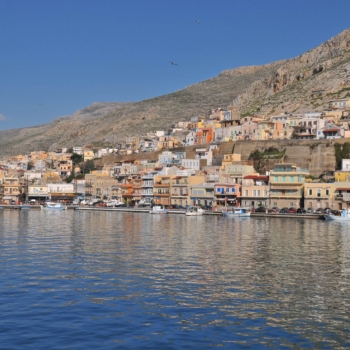The new Archaeological Museum of Kalymnos opened in 2009 and it is built in the centre of Pothia, the capital of the island. Until then, the mansion belonging to Katerina Vouvali, which was a donation of the owner, served as archaeological museum.
As soon as the new museum was created, the well-known “Kira of Kalymnos”, a significant artwork of the Hellenistic copper plating that represents a woman with her body covered by a tunic and frilled clothing finally found its place. It was traced in the sea of Kalymnos in 1995 by a local fisherman. The finding was then transferred to Athens and after having been subjected to maintenance it was hosted in the National Archaeological Museum. Since 2009, “Kira” constitutes the leading exhibit of the Archaeological Museum of Kalymnos.
Among other exhibits there are antiquities from the Prehistoric until the Post-Byzantine period, while the big number of sculptured votive offerings coming from the temple of Apollo of Delos as well as the huge religious statue of Asclepius are very impressive. In addition, among the exhibits, you can see copper and marble sculptures, exquisite ceramics, coins, jewelry, pictures and manuscripts of the Byzantine times, as well as many other things.
The visit begins with a short introduction concerning the history of the island and then you can visit the two exhibition halls and the museum floor. The first hall concerns the prehistoric life on the island, including findings emanating from excavations in caves (tools, utensils, vessels etc.) and findings of the Minoan period. There is a specific part dedicated to the most important religious and political centre of ancient Kalymnos, the temple of Apollo of Delos, and, more specifically, to the two deposits, where many votive offerings were found. There are also signs that provide valuable evidence regarding the public life of the islanders, honorary resolutions and testimonies concerning the role of women and the liberation of slaves.
In the second hall that mainly contains the findings of the ancient Hellenistic settlement called Damos there are silver and copper coins, minting of Kalymnos, Kos and other towns. Another part is dedicated to the necropolis of Kalymnos and to the valuable findings that emerged through their excavations, such as gold jewelry, diadems, crowns, earrings, rings, ceramic vessels, as well as other artworks of the glass-making industry. Nevertheless, “Kira of Kalymnos” and other copper parts of sculptures, which have been removed from the sea bottom, are dominant. The whole floor is dedicated to early Christian, Byzantine and post-Byzantine Kalymnos.
Info
Tel.: +30 22430 23113










